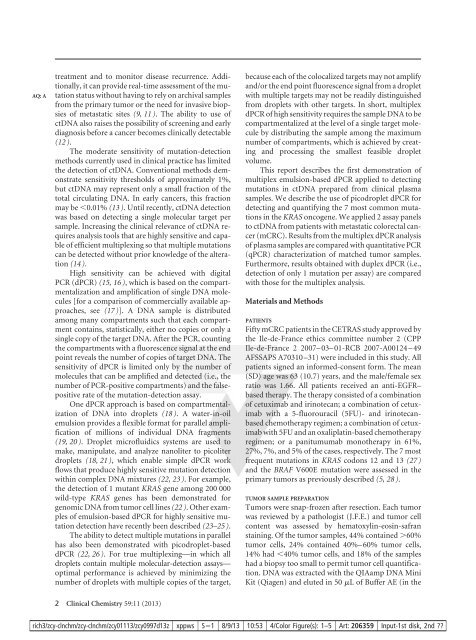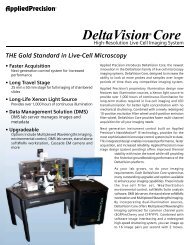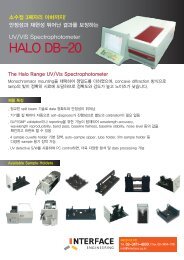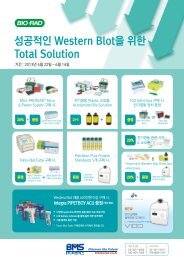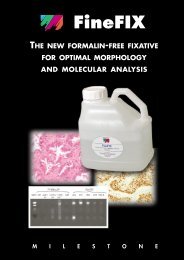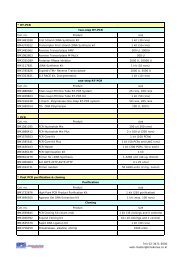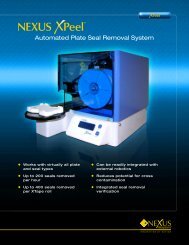Multiplex Picodroplet Digital PCR to Detect KRAS Mutations in ...
Multiplex Picodroplet Digital PCR to Detect KRAS Mutations in ...
Multiplex Picodroplet Digital PCR to Detect KRAS Mutations in ...
You also want an ePaper? Increase the reach of your titles
YUMPU automatically turns print PDFs into web optimized ePapers that Google loves.
AQ: Atreatment and <strong>to</strong> moni<strong>to</strong>r disease recurrence. Additionally,it can provide real-time assessment of the mutationstatus without hav<strong>in</strong>g <strong>to</strong> rely on archival samplesfrom the primary tumor or the need for <strong>in</strong>vasive biopsiesof metastatic sites (9, 11). The ability <strong>to</strong> use ofctDNA also raises the possibility of screen<strong>in</strong>g and earlydiagnosis before a cancer becomes cl<strong>in</strong>ically detectable(12).The moderate sensitivity of mutation-detectionmethods currently used <strong>in</strong> cl<strong>in</strong>ical practice has limitedthe detection of ctDNA. Conventional methods demonstratesensitivity thresholds of approximately 1%,but ctDNA may represent only a small fraction of the<strong>to</strong>tal circulat<strong>in</strong>g DNA. In early cancers, this fractionmay be 0.01% (13). Until recently, ctDNA detectionwas based on detect<strong>in</strong>g a s<strong>in</strong>gle molecular target persample. Increas<strong>in</strong>g the cl<strong>in</strong>ical relevance of ctDNA requiresanalysis <strong>to</strong>ols that are highly sensitive and capableof efficient multiplex<strong>in</strong>g so that multiple mutationscan be detected without prior knowledge of the alteration(14).High sensitivity can be achieved with digital<strong>PCR</strong> (d<strong>PCR</strong>) (15, 16), which is based on the compartmentalizationand amplification of s<strong>in</strong>gle DNA molecules[for a comparison of commercially available approaches,see (17)]. A DNA sample is distributedamong many compartments such that each compartmentconta<strong>in</strong>s, statistically, either no copies or only as<strong>in</strong>gle copy of the target DNA. After the <strong>PCR</strong>, count<strong>in</strong>gthe compartments with a fluorescence signal at the endpo<strong>in</strong>t reveals the number of copies of target DNA. Thesensitivity of d<strong>PCR</strong> is limited only by the number ofmolecules that can be amplified and detected (i.e., thenumber of <strong>PCR</strong>-positive compartments) and the falsepositiverate of the mutation-detection assay.One d<strong>PCR</strong> approach is based on compartmentalizationof DNA <strong>in</strong><strong>to</strong> droplets (18). A water-<strong>in</strong>-oilemulsion provides a flexible format for parallel amplificationof millions of <strong>in</strong>dividual DNA fragments(19, 20). Droplet microfluidics systems are used <strong>to</strong>make, manipulate, and analyze nanoliter <strong>to</strong> picoliterdroplets (18, 21), which enable simple d<strong>PCR</strong> workflows that produce highly sensitive mutation detectionwith<strong>in</strong> complex DNA mixtures (22, 23). For example,the detection of 1 mutant <strong>KRAS</strong> gene among 200 000wild-type <strong>KRAS</strong> genes has been demonstrated forgenomic DNA from tumor cell l<strong>in</strong>es (22). Other examplesof emulsion-based d<strong>PCR</strong> for highly sensitive mutationdetection have recently been described (23–25).The ability <strong>to</strong> detect multiple mutations <strong>in</strong> parallelhas also been demonstrated with picodroplet-basedd<strong>PCR</strong> (22, 26). For true multiplex<strong>in</strong>g—<strong>in</strong> which alldroplets conta<strong>in</strong> multiple molecular-detection assays—optimal performance is achieved by m<strong>in</strong>imiz<strong>in</strong>g thenumber of droplets with multiple copies of the target,because each of the colocalized targets may not amplifyand/or the end po<strong>in</strong>t fluorescence signal from a dropletwith multiple targets may not be readily dist<strong>in</strong>guishedfrom droplets with other targets. In short, multiplexd<strong>PCR</strong> of high sensitivity requires the sample DNA <strong>to</strong> becompartmentalized at the level of a s<strong>in</strong>gle target moleculeby distribut<strong>in</strong>g the sample among the maximumnumber of compartments, which is achieved by creat<strong>in</strong>gand process<strong>in</strong>g the smallest feasible dropletvolume.This report describes the first demonstration ofmultiplex emulsion-based d<strong>PCR</strong> applied <strong>to</strong> detect<strong>in</strong>gmutations <strong>in</strong> ctDNA prepared from cl<strong>in</strong>ical plasmasamples. We describe the use of picodroplet d<strong>PCR</strong> fordetect<strong>in</strong>g and quantify<strong>in</strong>g the 7 most common mutations<strong>in</strong> the <strong>KRAS</strong> oncogene. We applied 2 assay panels<strong>to</strong> ctDNA from patients with metastatic colorectal cancer(mCRC). Results from the multiplex d<strong>PCR</strong> analysisof plasma samples are compared with quantitative <strong>PCR</strong>(q<strong>PCR</strong>) characterization of matched tumor samples.Furthermore, results obta<strong>in</strong>ed with duplex d<strong>PCR</strong> (i.e.,detection of only 1 mutation per assay) are comparedwith those for the multiplex analysis.Materials and MethodsPATIENTSFifty mCRC patients <strong>in</strong> the CETRAS study approved bythe Ile-de-France ethics committee number 2 (CPPIle-de-France 2 2007–03–01-RCB 2007-A00124–49AFSSAPS A70310–31) were <strong>in</strong>cluded <strong>in</strong> this study. Allpatients signed an <strong>in</strong>formed-consent form. The mean(SD) age was 63 (10.7) years, and the male/female sexratio was 1.66. All patients received an anti-EGFR–based therapy. The therapy consisted of a comb<strong>in</strong>ationof cetuximab and ir<strong>in</strong>otecan; a comb<strong>in</strong>ation of cetuximabwith a 5-fluorouracil (5FU)- and ir<strong>in</strong>otecanbasedchemotherapy regimen; a comb<strong>in</strong>ation of cetuximabwith 5FU and an oxaliplat<strong>in</strong>-based chemotherapyregimen; or a panitumumab monotherapy <strong>in</strong> 61%,27%, 7%, and 5% of the cases, respectively. The 7 mostfrequent mutations <strong>in</strong> <strong>KRAS</strong> codons 12 and 13 (27)and the BRAF V600E mutation were assessed <strong>in</strong> theprimary tumors as previously described (5, 28).TUMOR SAMPLE PREPARATIONTumors were snap-frozen after resection. Each tumorwas reviewed by a pathologist (J.F.E.) and tumor cellcontent was assessed by hema<strong>to</strong>xyl<strong>in</strong>-eos<strong>in</strong>-safransta<strong>in</strong><strong>in</strong>g. Of the tumor samples, 44% conta<strong>in</strong>ed 60%tumor cells, 24% conta<strong>in</strong>ed 40%–60% tumor cells,14% had 40% tumor cells, and 18% of the sampleshad a biopsy <strong>to</strong>o small <strong>to</strong> permit tumor cell quantification.DNA was extracted with the QIAamp DNA M<strong>in</strong>iKit (Qiagen) and eluted <strong>in</strong> 50 L of Buffer AE (<strong>in</strong> the2 Cl<strong>in</strong>ical Chemistry 59:11 (2013)rich3/zcy-clnchm/zcy-clnchm/zcy01113/zcy0997d13z xppws S1 8/9/13 10:53 4/Color Figure(s): 1–5 Art: 206359 Input-1st disk, 2nd ??


